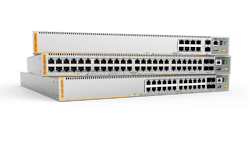Allied Telesis aims at Smart Buildings/Smart Cities and critical infrastructure opportunities with its new x530-28GSX full fiber switch, offering flexibility and network optimization to its x530 Series of multi-gigabit switches.
The product can be used in Smart Buildings to aggregate all building links in the basement, avoiding multiple racks. When used for a smart city application, the switch can drive the fiber link from an Industrial Ethernet switch in the cabinet to a dedicated room without an industrial aggregation switch in an outdoor cabinet.
Offering flexibility and network optimization for the company’s x530 Series of multi-gigabit switches, the x530-28GSX switch is a 24-port 100/1000X SFP stackable switch with 4 SFP+ ports and two fixed power supplies.
It can aggregate a 24x1 Gigabit fiber link to a 4x10 Gigabit fiber link, and up to 8 units can be stacked using Virtual Chassis Stacking (VCStack™) to build a 192 Gigabit fiber aggregator. The switch also supports copper connectivity via SFP/SFP+ ports, allowing the maximum flexibility of copper and fiber as required.
The product's ability to provide increased network capacity is a vital feature. Using fiber between access and aggregation removes distance limitations from existing copper cabling and optimizes network architecture and cost.
“The x530-28GSX enables the addition of bandwidth using either copper or fiber at either 1 or 10 Gbps, and because of its high resiliency, this capacity increase works very well for numerous large site markets such as education campuses, FTTx deployments, utilities, and city-wide metro networks,” said Todd Trenasty, VP of sales America at Allied Telesis.
He added that the product could protect government defense and critical infrastructure applications. “With the flexibility to provide over 200 fiber ports within a small, stacked footprint, they can be used in dense fiber-only networks such as defense and CNI (Critical National Infrastructure); coupling this with our Active Fiber Monitoring technology helps to reduce the chances of a cyber-attack on the attached passive infrastructure.”
For related articles, visit the Network Design Topic Center.
For more information on high-speed transmission systems and suppliers, visit the Lightwave Buyer’s Guide.
To stay abreast of fiber network deployments, subscribe to Lightwave’s Service Providers and Datacom/Data Center newsletters.

